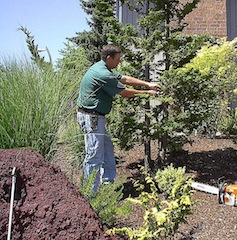Helpful Tree Care Tips From the City of Walnut Creek
 The City of Walnut Creek offers some great tree care resources and tips from their own arborist John Davis.
The City of Walnut Creek offers some great tree care resources and tips from their own arborist John Davis.
The main concerns when caring for your trees is to hire the right tree care specialist, make sure that you do not over-thin, and never top your trees as topping is one of the most harmful, yet commonly-used practices in tree care today.
Hire The Right Certified Arborist – If the trees around your home require that you climb a ladder or start a chainsaw in order to remove dead limbs or prune, then it’s probably time to hire some one to help you. When hiring a tree-care professional, it’s important that you hire a Certified Arborist. Certified Arborists are individuals who have achieved a level of knowledge in the art and science of tree care through experience and by passing a comprehensive examination. Certified Arborists not only know what they’re doing and will make the health of your trees a top priority, but they are licensed and carry insurance. It’s important to ask your tree care service for proof of insurance as you will be responsible for any injury or damage that occurs on your property. Also make sure that the tree care service you choose has a valid license certified by the California State Licensing Board. You can verify the legitimacy of the license by calling 1-800-321-CSLB, or use the website www.cslb.ca.gov.
Do Not Over Thin Your Trees – Keep in mind that the most important pruning in the life of a tree is done when the tree is young, this shapes the initial structure and strength of a tree. In mature trees, pruning should be limited to “crown-cleaning” which is the selective removal of “dead, dying, diseased, crowded; weakly attached and low-vigor branches from the crown of the tree.” Thinning should rarely, if ever, be done in mature trees as it can cause some major problems, like:
- Exposure of the bark to the sun resulting in sunscald and cracking of bark
- Rapid increase of growth, which depletes the tree of its natural reserves (food) and increases the likelihood of disease and pest problems.
- A lack of branch taper, which can lead to branch failure.
- The removal of living tissue decreases photosynthesis, which is a necessary process in the production of food for the tree for new growth and fighting disease and pest problems.
Harmful Tree Topping – Topping is perhaps the most harmful tree pruning practice known, yet it remains a common practice today. Topping stresses trees by removing much of the leaf-bearing crown. Since the leaves create the “food” for a tree, this can temporarily starve a tree and trigger a survival mechanism forcing the tree into “rapid growth” mode which, if the tree does not have enough stored energy reserves, can seriously weaken and kill the tree. A stressed tree is more vulnerable insect and disease infestations and topping also causes decay and can lead to sunburned branches.
Visit the Tree Care Industry Association web site for more helpful tips and information and to find a certified arborist in your area. Visit Walnut Creek’s Tree Care Tips & Regulations page for more information as well as for tree removal permit and application forms.
Share via social media






